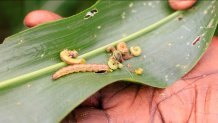
The fall armyworm caterpillar is known to eat more than 180 plant species
South East Asia and Australia face fall armyworm threat
Countries including China, Indonesia and Australia all face a “high threat” of invasion by the fall armyworm, new research shows.
The species, a moth whose caterpillars ravage crops, is native to the Americas but has spread to Africa and was recently discovered in India.
The new study, by the University of Exeter and the Centre for Agriculture and Biosciences International (CABI), shows South Asia, South East Asia and Australia have climates that would “permit the fall armyworm to invade”.
The researchers say trade and transport routes mean Australia, China, India, Indonesia, Malaysia, the Philippines and Thailand all face a “high threat of fall armyworm invasions originating from Africa”.
“We used data on how temperatures and rainfall affect the life cycle of the fall armyworm,” said Dr Regan Early, of the Centre for Ecology and Conservation on Exeter’s Penryn Campus in Cornwall.
“The species invaded and spread throughout sub-Saharan Africa within two years, and we wanted to understand where else it could establish itself.
“It’s clear that it could live in South Asia, South East Asia and parts of Australia all year round.
“The strongest climatic limits on year-round distribution are the coldest annual temperature and the amount of rain in the wet season.
“It is not yet clear whether the species could establish itself in North Africa and carry out seasonal migrations into southern Europe.”
The fall armyworm caterpillar is known to eat more than 180 plant species, including many crops relied upon by humans.
Recent estimates of 20-50% maize yield loss in Africa suggest severe damage to livelihoods.
Scientists believe the species may have arrived in Africa on a passenger flight, and the researchers called for vigilance to prevent the “onward invasion”.
“Prevention is more cost efficient and easier than control,” said Dr Roger Day, CABI’s Programme Executive for Action on Invasives.
“Effective prevention and management requires international cooperation and action.
“National governments can limit the movement of invasive species across borders through proper quarantine regulation and inspection, and by ensuring food supply chains follow appropriate measures.”
The paper is entitled: “Forecasting the global extent of invasion of the cereal pest Spodoptera frugiperda, the fall armyworm.”
Date: 20 August 2018
